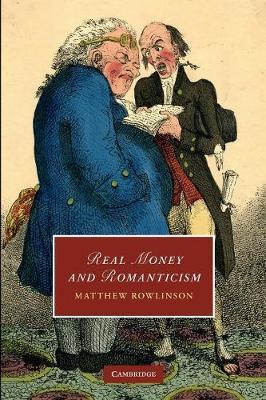Full Product Details
Author: Matthew Rowlinson (University of Western Ontario)
Publisher: Cambridge University Press
Imprint: Cambridge University Press
Volume: 85
Dimensions:
Width: 15.20cm
, Height: 1.40cm
, Length: 22.90cm
Weight: 0.360kg
ISBN: 9781107639478
ISBN 10: 1107639476
Pages: 268
Publication Date: 19 December 2013
Audience:
Professional and scholarly
,
Professional & Vocational
Format: Paperback
Publisher's Status: Active
Availability: Manufactured on demand

We will order this item for you from a manufactured on demand supplier.
Reviews
'Real Money and Romanticism raises questions that will be hard for economists and Romantic scholars alike to ignore.' Romantic Circles Rowlinson has achieved his major objective, and developed a new understanding of the connections between Romantic authors, their works, and money and capital. Best of all, this comes with a surprising timeliness: through his unexpected alignment with Randall Wray, Rowlinson situates himself at the cusp of neo-Keynsian thought, and in doing so evokes our own modern financial crises. Although Rowlinson shies away from making direct connections to the current economic climate, it is difficult to ignore the link, and Real Money and Romanticism raises questions that will be hard for economists and Romantic scholars alike to ignore. -Brett Mobley, Romantic Circles March 2011 The finest recent study of a general topic in the early nineteenth-century is undoubtedly Matthew Rowlinson's historically informed and theoretically inflected Real Money and Romanticism...Rowlinson embarks on an authoritative discussion of the different kinds of money and money substitutes that circulated in the literary worlds of Scott, John Keats, and Dickens, as well as the political economy of Karl Marx. His main contention is that all of these writers and thinkers absorbed into their work the difficulty of knowing when or if one's debts have finally been paid (p. 31). During an era when retail trade was enacted through instruments of credit, the fears surrounding paper money became a staple of cultural and political commentary, such as we find in the etchings of James Gillray. In his very smart chapter on Scott's fiction, Rowlinson observes that the unreliable method of bills of credit through which Scott received payment becomes a preoccupation in The Antiquary (1816). Rowlinson discerns that in this narrative indeterminate identification of things and of money itself is a more important topic than the identification of any character (p. 65). Similarly illuminating is his analysis of Keats's poetry and correspondence, in which Rowlinson sees the poet's preoccupations with his texts as bearers of value and obligation and with their status as stores of labor-or non-labor (p. 142). And in his discussion of The Old Curiosity Shop (1840-41), Rowlinson discovers that the eponymous setting of Dickens's novel is a place for objects that have lost their proper place, or for a residual materiality [End Page 915] that resists appropriation (p. 168). Such statements reveal that Real Money and Romanticism is a powerful ideas-driven study that integrates its findings about changes in the finance system into the very fabric of the literary works it analyzes. -Joseph Bristow, Recent Studies in the Nineteenth Century. SEL 51 (2011) What Rowlinson has done, above all, is make clear not only how difficult this history is but also how much the Romantics were obsessed with it. -Alexander Dick, Book Review
'Real Money and Romanticism raises questions that will be hard for economists and Romantic scholars alike to ignore.' Romantic Circles
Author Information
Matthew Rowlinson is an Associate Professor at the University of Western Ontario, where he teaches in the Department of English and at the Centre for Theory and Criticism.




